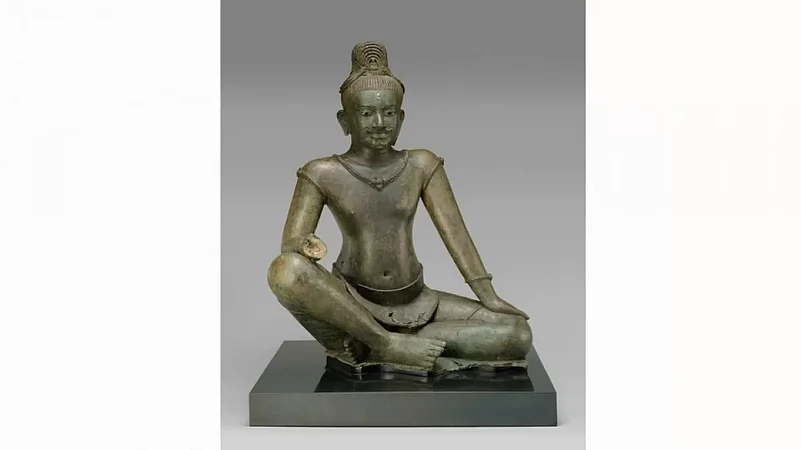The term "post-Covid" poses challenges, especially for those dealing with the disease or its long-term effects. However, in 2023, the World Health Organization declared that Covid-19 was no longer considered "a public health emergency of international concern," even though experts still classify it as a pandemic.
In response to this shift, many parts of the world witnessed a surge in spending, often referred to as "revenge spending," which provided a much-needed boost to struggling creative industries. However, it's worth noting that a subsequent slowdown is already taking place. Despite the backdrop of ongoing global issues such as war and technological disruption, the worlds of art, fashion, and culture found innovative ways to address and challenge society's most pressing problems.
Here are some of the influential factors that, for better or worse, encapsulated the spirit of the past year:
1. Two Women Dominated The Global And Musical Stage

Two of the major driving forces in the cultural economy were the concert tours of two highly successful female musicians: Beyoncé and Taylor Swift.
Taylor Swift's "The Eras Tour" achieved a historic milestone by becoming the first tour to gross over $1 billion in revenue. The demand for tickets was so overwhelming that during the Singapore leg, over 22 million people registered for the pre-sale, and more than a million people were in an online queue. This global phenomenon elevated the 34-year-old artist to even greater superstardom. It also prompted a congressional hearing in the United States to address concerns about the lack of competition in the ticketing industry, especially when Ticketmaster struggled to process orders. Furthermore, it had a significant impact on the travel industry, with hotels experiencing a surge in demand, and airlines adding extra flights to accommodate concert dates.
Beyoncé's "Renaissance" tour, on the other hand, contributed more than $4.5 billion to the US economy, as revealed by an analysis of concertgoers' spending conducted by the research firm QuestionPro. Interestingly, in Sweden, an economist at Denmark's Danske bank attributed the star's tour to contributing to inflation concerns in Stockholm. This was a result of the tour's kickoff in the city, which led to a substantial increase in hotel and restaurant prices.
2. ‘Barbenheimer’ was a Mega Phenomenon at the Box Office

Much like Beyoncé and Taylor Swift, Greta Gerwig's "Barbie" tapped into the spending power of women, who made up around two-thirds of the movie's audience. At the same time, the release of Universal Pictures' "Oppenheimer" sparked a significant studio rivalry, or perhaps more accurately, a mutually beneficial publicity campaign, reigniting America's love for going to the movies.
The sharp contrast between a witty feminist perspective on Barbie's predominantly pink world and the gripping tale of the father of the atomic bomb gave rise to some of the year's most entertaining memes, jokes, and parodies. It also led to the "Barbenheimer" challenge, where movie enthusiasts attempted to watch both films in succession on a single day. This trend turned both movies into viral sensations and generated excitement that translated into over $2.3 billion in global box office revenue. Remarkably, "Barbie" achieved the distinction of becoming Warner Bros.' highest-grossing film in its century-long history.
3. From Big To Bigger: Fashion's Largest Conglomerates Expanded Further

Fashion conglomerates strengthened their control over substantial portions of the fashion industry, solidifying their dominance in the $1.6-trillion luxury market in the current year. According to data from the Savigny Luxury Index as of March 2023, a market index managed by Savigny Partners, LVMH, Kering, and Richemont collectively possess a commanding 62% share of the luxury fashion market.
During the summer, Tapestry, the parent company of Coach and Kate Spade, merged with Capri, the owner of Versace and Michael Kors, in an impressive $8.5 billion deal. Meanwhile, LVMH, the conglomerate behind renowned brands like Louis Vuitton, Givenchy, Christian Dior, and Fendi, achieved a historic milestone in April by becoming the first European company to surpass a market value of $500 billion.
On the flip side of the industry spectrum, the prospects for independent high-end fashion labels seemed increasingly challenging. Self-funded designers encountered intense competition, and emerging, industry-recognized talent often struggled to sustain their brands.
4. Theft and Restitution of Art: A Continuing Saga

Art restitution involving museums and collectors facing pressure to return items of questionable origin continued to make headlines throughout the year. Institutions like New York's Rubin Museum of Art and the Metropolitan Museum of Art took steps to return artifacts taken from an 11th-century Nepalese monastery and archaeological sites in Southeast Asia. Similarly, the National Gallery of Australia and the family of the late American billionaire George Lindemann pledged to return looted objects to Cambodia. Additionally, the United States announced its intention to return 77 items to Yemen, among other notable cases.
One prominent exception in this trend has been the British Museum, which faced increasing calls to return disputed items from its extensive collection. Notably, the Parthenon marbles remained a focal point in a long-standing diplomatic dispute between the UK and Greece, which escalated during the year. British Prime Minister Rishi Sunak's refusal to meet his Greek counterpart and King Charles' choice to wear a tie featuring the Greek flag raised eyebrows in this context.
In an ironic twist, the British Museum itself fell victim to theft when it discovered that approximately 2,000 pieces from its collection were missing, with some even appearing for sale on eBay. The museum is actively pursuing recovery efforts and has appealed to the public for the return of these treasures.
5. SAG-AFTRA strikes brought Hollywood To A Standstill

Hollywood experienced a nearly four-month-long strike this year as actors demanded higher pay and improved residuals, which have dwindled in the era of streaming platforms that often bypass traditional royalty structures and keep viewership data confidential. According to the US Bureau of Labor Statistics, actors earned an average of $27.73 per hour last year, and many struggled with irregular income due to the seasonal nature of their work. This strike also affected writers, leading to the halt of movie and television productions.
Award ceremonies were either downsized or postponed, resulting in unusually subdued red carpet events. While this posed challenges for celebrity makeup artists and stylists who lost a significant source of income, it created opportunities for influencers and models to step into the spotlight usually occupied by movie stars.
In November, the actors' union SAG-AFTRA finally reached a settlement with major studios, culminating in an agreement that will remain in effect until May 2026. The deal includes pay raises, extended job durations, improved benefits, royalty assurances, and safeguards against the studios' use of artificial intelligence—a significant concern for both actors and writers during the negotiations.
6. AI's Ongoing Battle with Creative Minds

Not only screenwriters and actors, but also authors such as George R. R. Martin, Jodi Picoult, and John Grisham, became concerned about AI potentially jeopardizing their work. They joined a class action lawsuit against OpenAI, the company responsible for ChatGPT, alleging the use of copyrighted material in training its systems to generate more human-like responses. Over 10,000 authors, including James Patterson, Roxane Gay, and Margaret Atwood, signed an open letter urging leaders in the AI industry to seek author consent when using their work to train large language models and to provide fair compensation for such usage.
Visual artists also took measures to protect their work from AI usage without their permission. Programs like Glaze were developed to manipulate images in ways that AI models perceive differently from human eyes, such as making an oil painting appear as a charcoal drawing. PhotoGuard was another tool created to prevent the unauthorized manipulation of images.
Also Read: AI: The Question of Chaos, Intrigue And Jobs
In various fields, competition from emerging technology became apparent. In a noteworthy example, an AI-generated image won a Sony World Photography Award in April. Nevertheless, many creatives recognized the potential of these developments, with examples ranging from Japan's first AI-generated manga comic to entire fashion collections designed with the assistance of AI technology.
7. NFTs Plummet to Unprecedented Depths

While the explosive rise and fall of NFT prices dominated headlines in 2022, this year brought a more realistic and sobering outlook for token enthusiasts. As trading volumes plateaued, some of the individuals and companies associated with celebrity-endorsed collectibles faced a fresh wave of legal challenges.
In April, investors initiated lawsuits against the creators of Bored Ape NFTs, including Yuga Labs, alleging "misleading" promotion and artificial inflation of token prices. Yuga Labs responded at the time, stating that the claims were baseless. Soccer superstar Cristiano Ronaldo also found himself facing a $1-billion class-action lawsuit related to his endorsement of the crypto exchange Binance and the sale of NFTs featuring himself. Additionally, a federal jury in New York ruled that an artist's NFT versions of Hermes' iconic Birkin bags infringed upon the luxury brand's trademark rights.
With Bitcoin prices experiencing a recent resurgence, some crypto analysts hold out hope that the "NFT winter" may be drawing to a close. However, despite a modest increase in sales in November, returning to previous heights remains a challenging journey.
8. Miss Universe: Tiaras, Trans Rights, and Turmoil Take Center Stage

Irrespective of one's perspective on the relevance of the Miss Universe competition in today's world, this year's pageant has generated more discussion and controversy than any in recent memory. Notably, the competition marked a significant step towards LGBTQ inclusion as it featured two transgender women for the first time. Marina Machete and Rikkie Kollé represented Portugal and the Netherlands, respectively.
However, just days before the finale in El Salvador, the owner of Miss Universe, JKN Global Group, filed for bankruptcy, creating uncertainty. Despite this financial setback, the Thai media distribution company successfully organized a glamorous event, complete with elegant evening gowns and some eccentric "national costumes."
The drama didn't end there. After Sheynnis Palacios of Nicaragua claimed the title, it was followed by a shocking turn of events. Karen Celebertti, the director of the Miss Nicaragua franchise, faced charges of conspiracy and treason. Alongside her husband and son, she was accused of involvement in a plot to overthrow the government. In response, Celebertti resigned from her position.
9. Whispers of 'Quiet Luxury'

In a year marked by a global cost-of-living crisis driven by escalating inflation and surging energy and food prices, 2023 emerged as the era of "quiet luxury." This concept revolved around the idea that wealth should convey itself with subtlety rather than extravagance, leading to a new wave of restrained simplicity that extended beyond the fashion runways.
HBO's "Succession," which concluded its fourth and final season in May, played a pivotal role in popularizing the "stealth wealth" trend. The show's ultra-rich characters often favored elevated basics, and the sartorial choices of characters like Shiv Roy's work attire and Kendall Roy's baseball caps became notable talking points. Similarly, Gwyneth Paltrow's high-profile yet unassuming courtroom wardrobe garnered significant attention, sometimes overshadowing the ski accident that was the subject of the trial.
The mourning dress codes depicted in 'Succession' served as a source of inspiration for this trend. Brands like Prada began to present their new menswear collections as "a reconsideration of simple things," and celebrated designer Phoebe Philo launched her highly anticipated eponymous label with a debut collection characterized by understated elegance. This trend extended beyond fashion into watches, accessories, and even the world of hotels, as exemplified by jeweler Chopard's new "anti-hotel" concept located in the heart of Paris.
10. Auction Houses Navigate Turbulent Seas

In the world of art auctions this year, a few items grabbed the spotlight with incredibly high prices. Two notable pieces that reached the nine-figure mark include a Picasso masterpiece called "Femme à la montre," which sold for over $139 million, making it one of the most valuable works by the Spanish artist ever auctioned. Another highlight was Gustav Klimt's final portrait, which became the most expensive artwork ever sold at a European auction, fetching around $108 million in London.
Overall, however, the art market experienced sluggish sales. For example, Christie's reported a year-on-year drop of $2.2 billion in sales in 2023, and Philips witnessed a nearly 40% decline in the first half of the year compared to the same period in the previous year.
To adapt to these challenges, auction giants have diversified their offerings, including sales of sneakers and sports memorabilia in 2023. Nevertheless, their core success still relies on high-value art sales, which have seen a significant drop. According to an analysis by Artsy, the top 100 auction lots this year totaled $2.4 billion in sales, down from $4.1 billion in 2022.
Similar to museums, auction houses have faced scrutiny regarding the origins of the items they handle. In September, Christie's canceled a sale of jewelry owned by the late billionaire Heidi Horten due to concerns raised by Jewish advocacy groups and human rights organizations. These concerns revolved around her husband's acquisition of Jewish businesses under duress in Nazi Germany, which contributed to their family fortune.
11. Hidden Treasures Found

In 2023, thrift shoppers around the world had some incredible finds that turned into substantial profits. In the UK, a couple stumbled upon a tiny vase by a Japanese ceramic artist, buying it for just $3.30, only to discover later that it was worth nearly $12,000. Meanwhile, an anonymous collector in the UK sold two Qing dynasty jars for over $74,000, having acquired them as part of a ceramics batch for just $25.
In the United States, an antiques enthusiast bought an item for $4, which later fetched a staggering $191,000 at auction when it was revealed to be a long-lost N.C. Wyeth painting. There was some drama around the sale, as it initially fell through but eventually found a buyer for an undisclosed six-figure sum. More recently, in Richmond, Virginia, a thrift shopper made a remarkable profit by purchasing a glass vase for $3.99 at Goodwill, only for it to be identified as the work of Italian architect Carlo Scarpa and sell for over $107,000.
The art world also saw surprising discoveries, including corrected attributions. For example, a painting that was once sold at auction for $15,000 turned out to be a Rembrandt and fetched almost $14 million this month. Additionally, there were unexpected returns, such as a stolen Van Gogh painting that was delivered to a Dutch art sleuth in an IKEA bag.



























